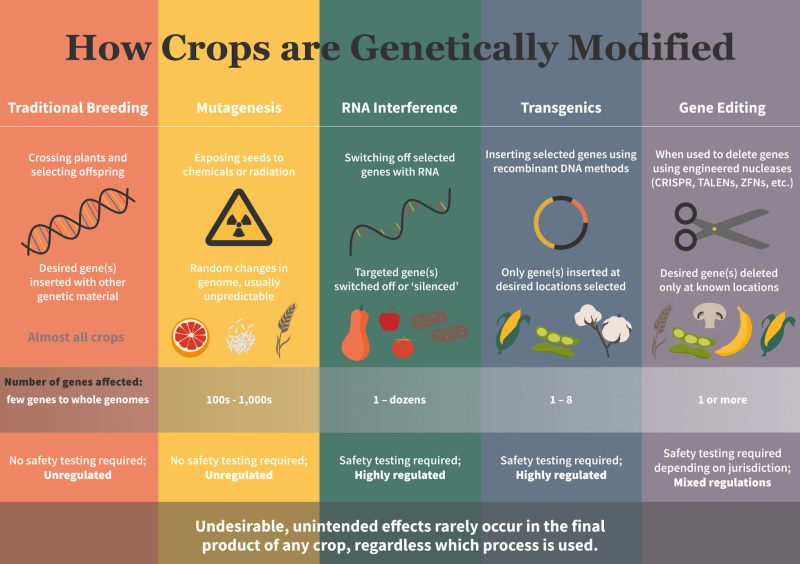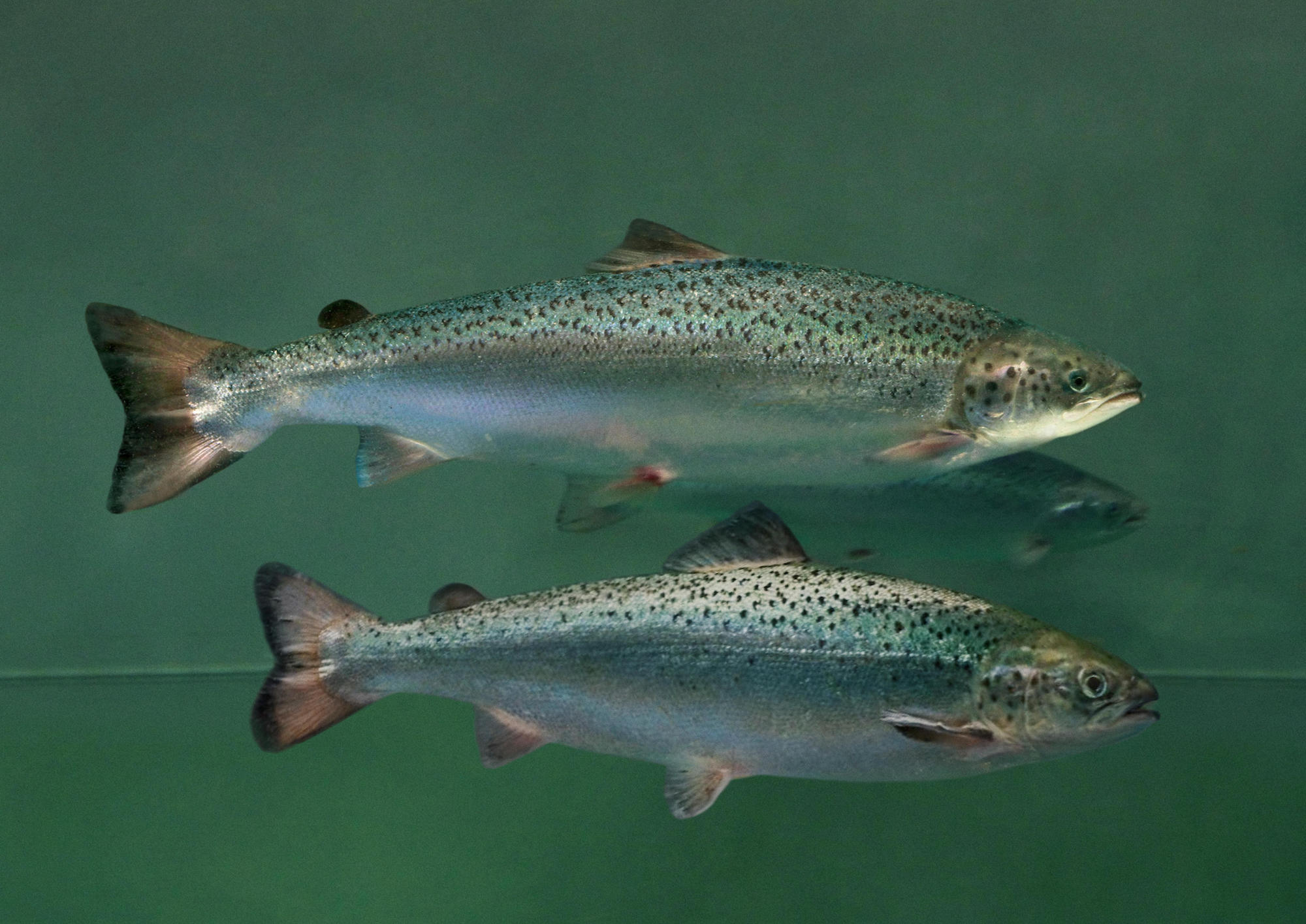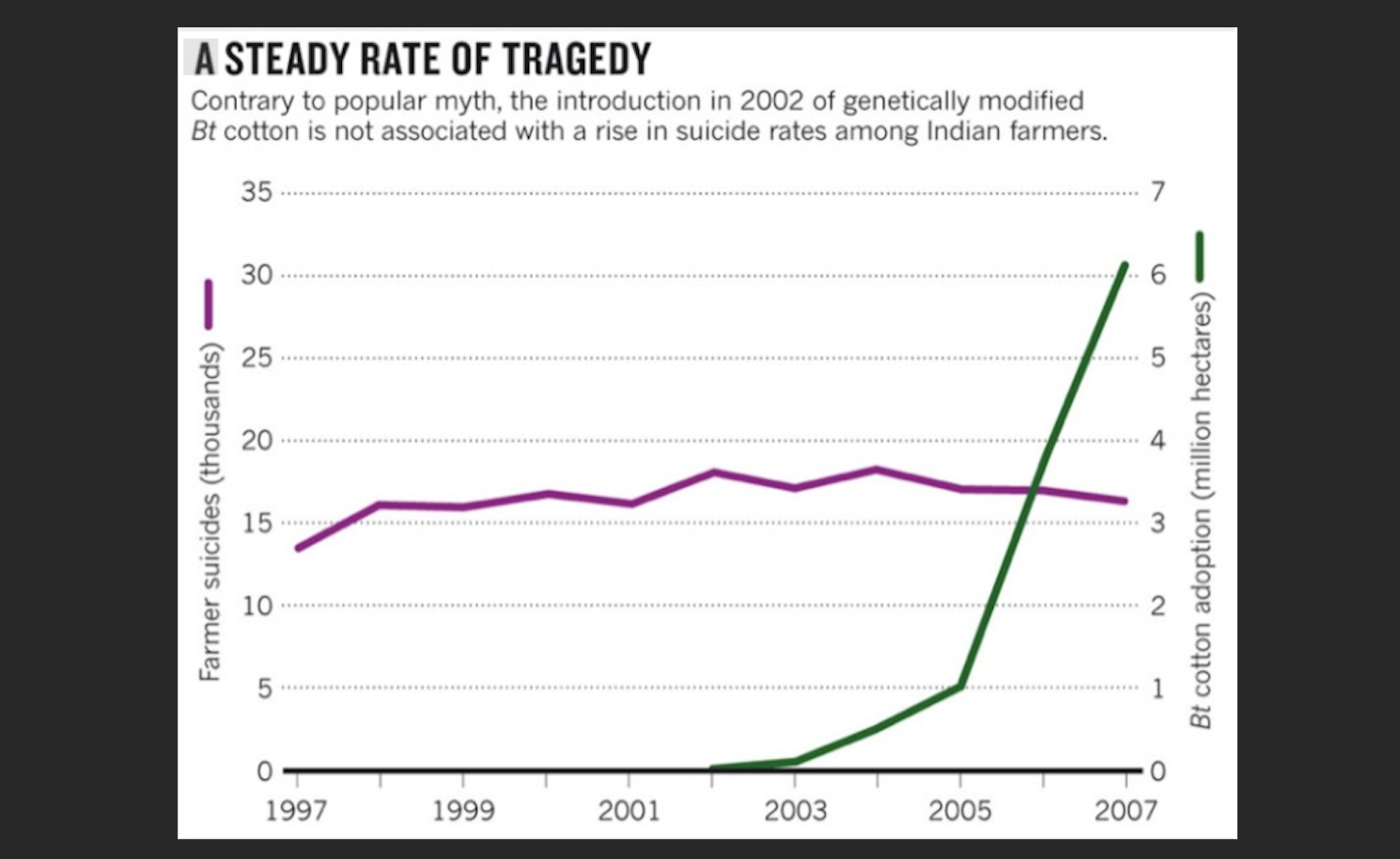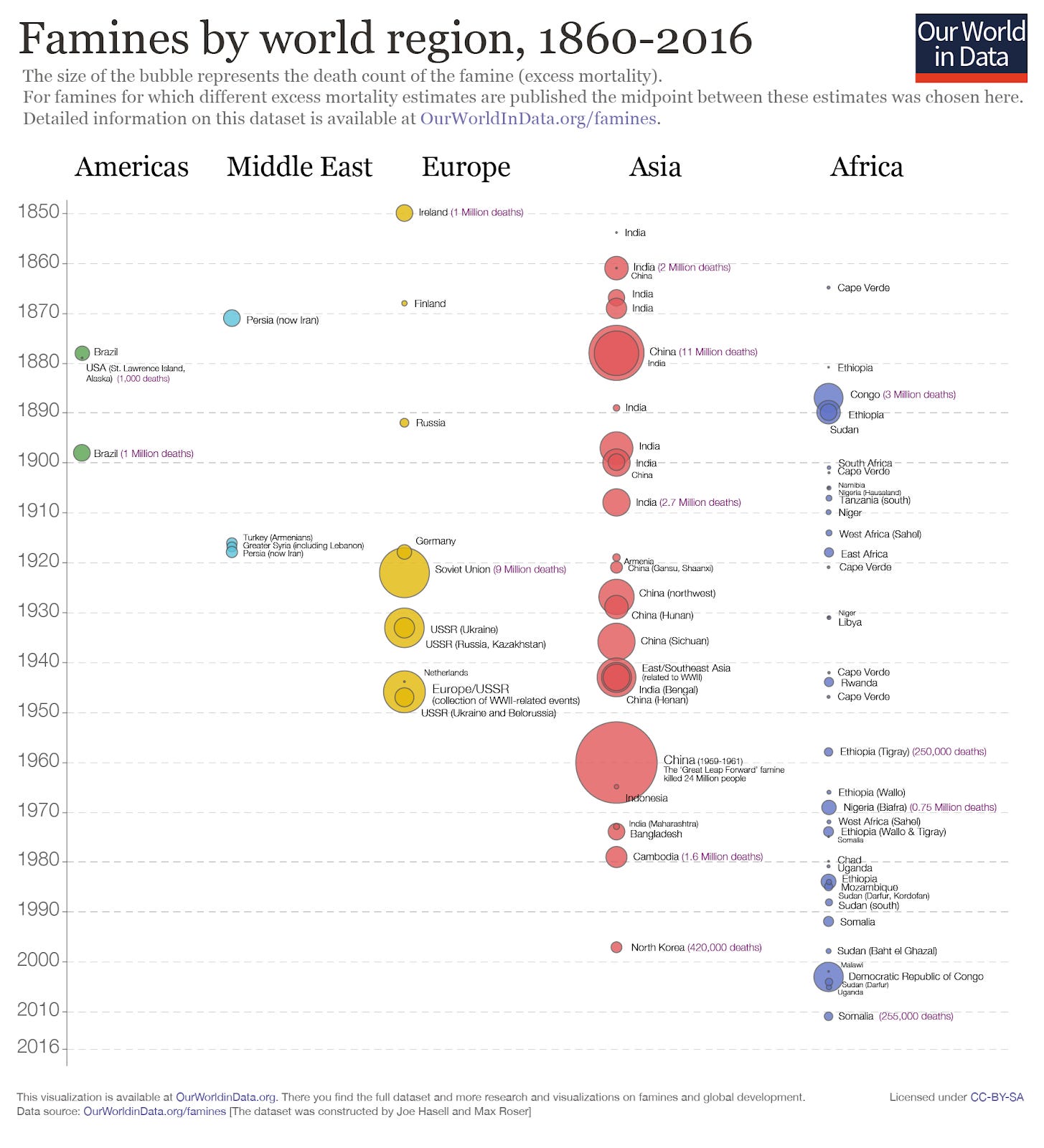Science / Tech
The European Union Is Finally Coming Around to Gene-Edited Seeds
For a quarter century, activists such as Vandana Shiva have opposed GM crops that can help feed the world. Now, more than ever, it’s time to reject their Luddite demands

In 2021, the European Union announced that it would be reviewing its 2001-era legislation governing genetically modified (GM) organisms, so as to properly account for the recent development of “gene-edited” crops, which are produced using what’s known as New Genomic Techniques. To laypeople, the distinction between the various technology types may seem obscure. But from a scientific point of view, the difference is significant.
Genetically modified organisms—also known as transgenic organisms, or GMOs—have been around since the 1990s. Many well-known GMOs have been developed by combining DNA from different types of organisms, a process that has aroused fears of “frankenfoods” (a pejorative term coined three decades ago by Boston College professor Paul Lewis, who wrote, “If they want to sell us Frankenfood, perhaps it's time to gather the villagers, light some torches and head to the castle”).
By contrast, New Genomic Techniques (NGTs) allow scientists to manipulate specific regions of a genome directly—so as to reduce the need for pesticides, resist disease, boost yields, or enhance resilience in the face of climate change—without importing genetic material from outside sources. CRISPR-Cas9 (typically rendered simply as CRISPR), the leading technology in this area, is analogized to a pair of genetic scissors that scientists can use to surgically remove, add, or reorder genetic material on a molecular level.
This is not just some superficial branding change that corporations have slapped onto legacy GMO technology. NGTs represent an enormous technological leap, as evidenced by the fact that the two scientists who developed CRISPR in the 2010s received the 2020 Nobel Prize in Chemistry for their work.
Two years following the EU’s 2021 announcement, the European Commission (the EU’s executive branch) is now proposing to loosen its restrictive GM rules in cases where gene-edited crops have been subject to no more than 20 specific gene modifications. A leaked draft of the proposed legislation suggests that under the new rules, EU countries would no longer be able to ban the cultivation of NGT crops. The decision is based on an extensive study that found, as an EU Vice-President put it, “there is sufficient evidence and scientific basis to initiate a targeted policy action on plants derived from certain new genomic techniques”—i.e., NGTs.
Such plants would be treated, for regulatory purposes, in the same way as plants bred by traditional methods. This means they would not be subject to the extensive risk-assessment protocols applied to GMOs, nor to labeling requirements that serve to identify foods as genetically modified.

If implemented, this welcome proposal would open the door to many new products. It would also help bring Europe’s regulatory policy into the 21st century. As GM crops have become widely adopted in many parts of the world, a scientific consensus has emerged to the effect that these plants are as safe to eat as any other food. Yet public distrust and intense lobbying by activist groups has largely stymied the adoption of GM foods in Europe, where only a handful of genetically modified products have been authorized (mainly for animal feed). Moreover, Europe’s overly cautious approach has, in turn, encouraged the adoption of similarly restrictive policies in developing countries.
Unlike Canada and the United States, where the use of GMOs is generally uncontroversial, the EU is a supranational organization with 27 member countries. And so EU policymakers must navigate many different sets of culturally-specific, historically rooted attitudes in regard to how foods should be produced, sold, marketed, and consumed. Not all of these attitudes are consistent with science.
Some of the biggest fights among EU members over the years have played out over bananas, cheese, beef, and the union’s Common Agricultural Policy more generally. Sentimental appeals to natural purity and traditional recipes still resonate strongly with many Europeans, which is why there’s still an Italian organization that certifies the authenticity of Neapolitan pizzas, while Germany still enforces a 500-year-old law regulating beer ingredients—the Reinheitsgebot—dating to the era of Charles V.
The Hungarian government has responded to the proposed EU legislation by stating that it considers all genetically altered foods to be too risky, scientific research notwithstanding. Slovakia’s government, similarly, rejects the idea that there is any meaningful distinction to be made between modern gene-editing techniques and the GMOs that EU rules were originally drafted to address. Not surprisingly, many Green Party politicians and activist organizations such as Greenpeace have also expressed reflexive opposition to the proposed regulatory changes, judging (perhaps correctly) that many voters and donors will fail to investigate the important technological advances that have taken place since these groups first staked out their anti-GMO positions in the late 1990s.
All of these objections seem divorced not only from the actual science at play, but also from the enormous benefits that have already followed from the genetic modification of life-sustaining crops. And keep in mind that these benefits have come from legacy GMO technologies. NGTs promise even greater benefits, at even lower risk, through the application of more precise and predictable forms of genetic manipulation.
In Kenya, farmers are turning to genetically modified crops to help them adapt to increasingly dry conditions. By lifting a 10-year ban on GMOs, the Kenyan government has allowed its farmers to cope with the increasingly dire effects of climate change. Ironically, one of the main barriers to such a step had been the lobbying conducted by progressive Western environmentalists, who loudly trumpet the effects of global warming, even while seeking to deny farmers in poor countries an important tool for dealing with it.

Many Europeans have the privilege of adhering to nostalgic ideas about food sourcing. Agriculture contributed just 1.4 percent to the EU’s GDP in 2022. In Kenya, by contrast, the corresponding figure is 33 percent. And fully 80 percent of rural Kenyan employment is connected to farm work. This is a part of the world where the risk of famine remains real.
Maize is a staple food among Kenyans, who use it to prepare ugali, a round cake that is the country’s most commonly eaten dish. Genetically modified maize has become attractive to Kenyan farmers because more traditional forms of maize production are sensitive to temperature fluctuations. Moreover, a meta-review published in Nature found that between 1996 and 2016, genetically engineered maize provided farmers with a substantially higher yield than the traditional variety, and lower concentrations of poisonous fungi and mold.

My earliest understanding of GMOs came from a National Geographic article that had been written for young readers. While the authors noted that “genetic engineering typically changes an organism in a way that would not occur naturally…rais[ing] the possible risk of unexpected allergic reactions to some GMO foods,” they also noted that we have all been eating genetically engineered plants since the 1990s, and that
today, approximately 90 percent of the corn, soybeans, and sugar beets on the market are GMOs. Genetically engineered crops produce higher yields, have a longer shelf life, are resistant to diseases and pests, and even taste better. These benefits are a plus for both farmers and consumers. For example, higher yields and longer shelf life may lead to lower prices for consumers, and pest-resistant crops means that farmers don’t need to buy and use as many pesticides to grow quality crops. GMO crops can thus be kinder to the environment than conventionally grown crops.
This was not a press release from a large biotechnology company or a pro-GMO lobbying group, but rather a highly respected journalistic publication. As someone who’d attached herself to the environmentalist movement, I began to scrutinize the hostility to genetic technology evinced by many of its leading figures.
As noted above, the case for gene-edited crops produced using NGTs is even stronger than the case for GMOs, because the benefits of enhanced crops can be achieved with highly focused genomic alterations that do not involve importing foreign genes. In many cases, in fact, gene-editing is basically just a high-tech means of customizing and accelerating the (otherwise random) genetic mutations observable in all life forms.
For thousands of years, human cultivators have relied on such mutations to selectively re-plant and cross-breed organisms based on the appearance of specimens exhibiting desired characteristics, such as, say, sturdy roots. CRISPR and other NGTs allow this process to proceed to its desired conclusion without lengthy and wasteful breeding programs. Why wait decades for the random mutations necessary to produce the kind of durable maize that Kenyan farmers need right now as a means to ward off bankruptcy and hunger?
Another factor at play is the outsized influence of anti-GM figures such as celebrity activist Vandana Shiva, who has equated GMOs with “poison” and “food totalitarianism.” Former White House Press Secretary Bill Moyers has called her “a rock star in the worldwide battle against genetically modified seeds.”
Having been charmed by the grandmotherly Shiva, I came to believe that she was fighting a righteous battle against powerful corporations. One still hears activists parroting her claims on social media, despite the scant evidence available to back them up. Which shouldn’t be particularly surprising: a scientific study published in 2019 found that, as a New York Times headline-writer put it, “people who are the most extremely opposed to genetically modified organisms tend to know the least about them.”
"Food is a weapon.
— Earthist 🌱 (@earthistdao) May 26, 2023
When you sell real weapons, you control armies.
When you control food, you control society.
But when you control seed, you control life on #Earth"@drvandanashiva pic.twitter.com/JcTJ7IH7Wc
Born in the Northern Indian city of Dehradun to a government official and a school inspector, Shiva is lucky enough to count herself among India’s wealthy elite. After pursuing post-graduate education in Canada and India, she founded the activist group Navdanya, which promotes organic farming, seed saving, and anti-GMO protests. Branding itself as “farmer-led,” “Earth Centric,” and “Women Centric,” the group has displayed a certain genius for messaging that channels the gauzy reveries of privileged western supporters:
We live and practise the philosophy of Earth Democracy as one Earth Family (Vasudhaiva Kutumbakam) with no separations between nature and humans and no hierarchies between species, culture, gender, race, and faiths. We have conserved our rich seed heritage of nutritious, climate-resilient food in more than 150 community seed bank[s], freely saving, sharing, and breeding our native varieties.
Journalists have often portrayed Shiva as a hero, and she has won numerous awards. In 2010, for instance, Shiva was awarded the Sydney Peace Prize for her commitment to social justice and her defence of the poor. Beloit College in Wisconsin honoured Shiva with its Weissberg Chair in International Studies, calling her “a one-woman movement for peace, sustainability, and social justice.”
There’s always been something of a “guru” halo surrounding Shiva (and I write this as an Indian woman who has herself, while growing up in the UK, sometimes been described as having some “mystical” quality about me). Indeed, Shiva plays up to this stereotype. When I travel, I go on a trip. When Shiva does it, it’s a “pilgrimage.” Wise Yoda-like adages about the essence of life spring easily from her lips, to be eagerly lapped up by Western journalists.
It’s easy to forget that Shiva is not a farmer, nor does she come from a farming background. And while she counts as a “diverse” female for Western purposes, she’s hardly diverse by Indian standards. Most of us are brown.
As a young environmentalist, however, I had no reason to doubt her heroine status. Shiva’s simple good-versus-evil message—farmer-versus-corporations, people-versus-profits, women-versus-the patriarchy—fed perfectly into the worldview of a young activist seeking a sense of absolute moral certainty.
There was also a personal dimension to Shiva’s message, as she claimed that the introduction of genetically-modified cotton seeds produced by Monsanto (which has since been acquired by Bayer AG), beginning in 2002, had been responsible for a “genocide”-level surge of suicides among Indian farmers. Since my own parents descend from rice farmers in India’s rice-growing Punjab region, I was shocked when I first heard this. Emboldened by Shiva’s claims, I organized a seed swap in the English city of Exeter, where my family lived, along with other idealists who sought to teach local residents how to practice sustainable gardening and boycott “Big Agro.”

The Exeter Seed Swaps were successful events, attended by hundreds of people. And the experience made me feel like I was walking in Shiva’s footsteps. While I doubt that handing out free seeds and encouraging people to grow their own plants was anything but harmless, I now realize that my motives for doing so were based on misinformation. As it turns out, Shiva’s claimed linkage between Indian farmer suicides and GM cotton appear to have been baseless.

To be fair, some of Shiva’s concerns really did contain a grain of truth—such as her warnings about so-called “terminator”-style GM seeds that do not reproduce, thus requiring farmers to buy new seeds every year. But Shiva has extrapolated such concerns to terrifying extremes, suggesting, for instance, that sterility in seeding plants will lead to a global cataclysm that eventually will destroy all higher forms of life, including humans.
This is a frightening prospect. But as it turns out, terminator seeds do not exist in the real world, having been dropped from development almost a quarter century ago; and there has long been an international moratorium on their use.
I also began to scrutinize Shiva’s broader claims about the effect of technology on food production, which seemed to contradict incontrovertible evidence in regard to the life-saving effects of the twentieth-century Green Revolution, during which, as Cornell University expert Prabhu L. Pingali has put it,
the developing world witnessed an extraordinary period of food-crop productivity…Although populations had more than doubled, the production of cereal crops tripled during this period, with only a 30 percent increase in land area cultivated. Dire predictions of a Malthusian famine were belied, and much of the developing world was able to overcome its chronic food deficits.
In India and Pakistan, specifically, the adoption of new crop varieties during the late 1960s caused wheat yields to nearly double. If either nation had stuck to traditional farming methods, as Shiva apparently would have preferred, millions of people would have starved.
Like China, India was regularly afflicted with famines that killed millions of people until well into the twentieth century. Notwithstanding Shiva’s apocalyptic claims that modern technology would lead to mass starvation, neither country has witnessed a famine in the last half-century. Since the 1980s, in fact, the only Asian country that has experienced a famine is the hermit kingdom of North Korea, whose communist economy channels the same collectivist ideals that many utopian environmentalists still endorse.

In some cases, Shiva’s bad ideas have had dire real-world outcomes—as with Golden Rice, a form of white rice that has been genetically modified in a way that could help save millions of people in the developing world.
Every year, up to 500,000 children in the developing world go blind due to Vitamin A deficiency; and half of them die within 12 months of losing their sight. Typically, these are Asian and African children whose daily diet consists of little (or nothing) more than ordinary rice, which contains no β-carotene (provitamin A), the substance that our bodies convert into Vitamin A. A single bowl of cooked Golden Rice, on the other hand, can provide 60 percent of the recommended nutrient intake of Vitamin A for children aged between six and eight.
Yet Shiva has claimed that Golden Rice is a “hoax,” and lectures the world’s poor to instead pursue dietary “diversity” as a means to ward off malnutrition. That is great advice for wealthy people at a buffet or grocery store, but not so useful for subsistence farmers and their families, whose diet can sometimes consist of rice or…nothing at all.
Alas, the scaremongering against Golden Rice has worked. In 2013, activists destroyed crops at an experimental field trial in the Philippines. And even now, the product still hasn’t been brought to market. In 2016, a group of over 100 Nobel Laureates signed an open letter calling this anti-GMO vilification campaign a “crime against humanity.”
Fortunately, some farmers have started fighting back—part of a grass roots movement that rejects Shiva’s scientifically discredited efforts to deny them the benefits of what’s been called the next Green Revolution. Earlier this year, for instance, pro-GMO activists and farmers marched in Kenya and Uganda to protest remaining GMO bans and call for the adoption of improved seed varieties.
In 2019, an Indian farmers’ union, Shetkari Sanghatana, announced that it would sow genetically altered crops in the Indian state of Maharashtra, in defiance of government policy. The group is also using the courts to oppose laws that, by blocking access to GM crops, would prevent the farmers the right to (in their words) “choose and live a dignified life.”
“Genetically modified seeds are being used all over the world and we have seen that the costs are less, pest attacks are fewer, and the yields are higher,” the group’s president told reporters. “They are definitely much better for the farmer.”
One thing I haven’t yet mentioned about Shiva, but which is important to add, is that her ancestry is tied to India’s upper-caste Brahmin community—a status shared by only about 4.3 percent of the total Indian population.
While caste discrimination has (rightly) been illegalized in India, caste remains a lingering marker of privilege. And given that few of Shiva’s Brahmin ancestors would ever have had any experience as humble farmers (a low-status profession mostly left to Shudras, Dalits, and Adivasis), her claim to speak on behalf of the nation’s impoverished agricultural sector seems not only scientifically dubious and economically destructive, but also socially—and even morally—perverse.
Here is a wealthy Brahmin woman with no actual “lived experience” (as the expression goes) as a farmer, demanding that the lower castes adhere to her baseless phobias about technology—arguments that, if followed, would lead countless Indians to poverty, ill health, and even the risk of death.
“Should a Brahmin be speaking for Shudras?” I rather bluntly asked my father once. He looked at me blankly. “What do they know about farming?” he asked. It’s a good question.

In some ways, Hindu mysticism may be working at cross-purposes with scientific reality. Vanadana Shiva’s supernatural namesake, one of the principal deities of Hinduism, is held to portray the peasant farming lifestyle as a sacred stewardship of the land. It’s an appealing image that informs not only the organic rhapsodies of wealthy Indians such as Vanadana Shiva, but also those of naïve Western progressive consumers. The reality is that small-scale farming was always a brutal way to make a living, especially before the development of modern farming machinery and improved crop seeds. In India, unfortunately, that description still fits, in part thanks to the efforts of Shiva and other ideologically-driven agricultural Luddites.
For more than two decades, the European Union has acted as something of a swing vote on the internationally debated question of GM technology, amplifying activist concerns on behalf of a multinational bloc that represents a sixth of the world economy. And the possibility that the EU will finally see the light on this crucial issue offers hope to millions of consumers and farmers—not just in Europe, but everywhere—who have till now been denied the benefits of GM technology.
NGT crops can help societies all over the planet ward off starvation, malnutrition, blindness, poverty, and climate impacts. If Europe’s anti-technology activists prevail, on the other hand, we may have to wait another generation until the will for reform returns. If so, the greatest victims will be those, such as Shiva’s fellow Indians, who already have been made to sow the earth with yesterday’s seeds.







